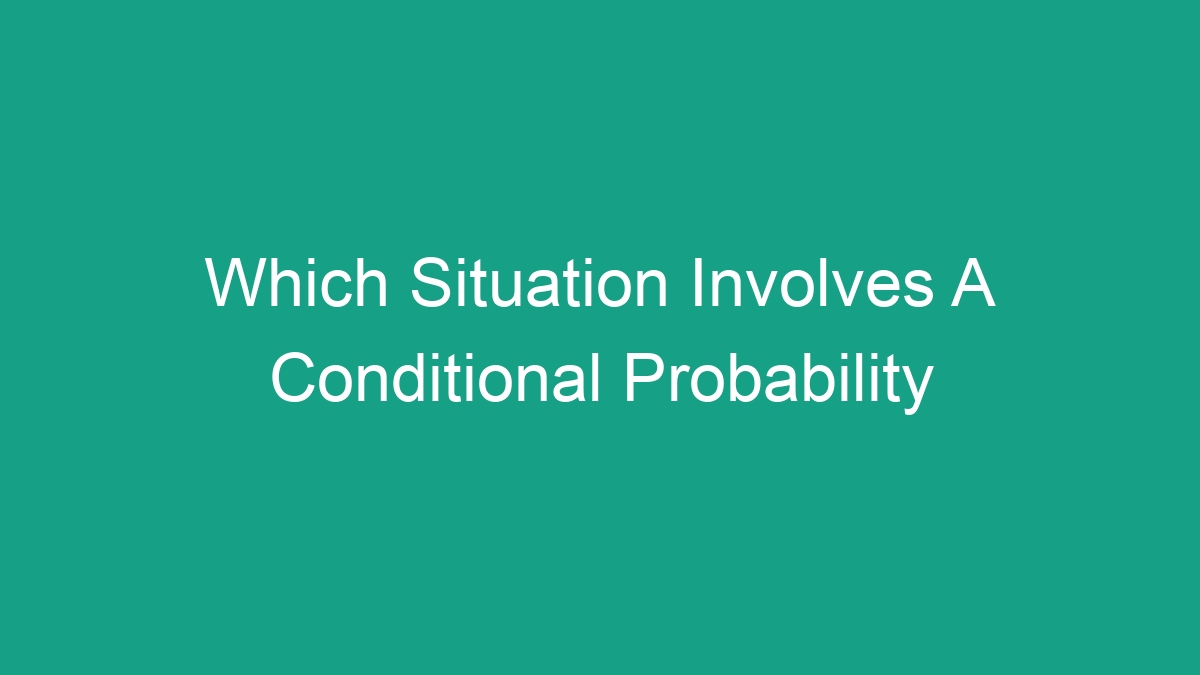
Conditional probability is a concept that is widely used in the field of probability and statistics. It refers to the probability of an event occurring given that another event has already occurred. In other words, it is the likelihood of a particular outcome, given certain conditions or circumstances.
What is Conditional Probability?
Conditional probability is denoted by P(A|B), which reads as “the probability of event A given event B”. This concept is used to calculate the likelihood of one event occurring, based on the occurrence of another event. It is particularly useful in situations where events are not independent, meaning that the occurrence of one event affects the probability of another event.
Examples of Situations Involving Conditional Probability
Conditional probability arises in various real-life scenarios. Here are some common situations where conditional probability comes into play:
- Weather forecasting: The probability of rain on a given day, given that it is cloudy.
- Medical diagnosis: The likelihood of a patient having a certain disease given their symptoms.
- Market research: The probability of a customer making a purchase, given that they have added an item to their online shopping cart.
- Sports analytics: The probability of a team winning a game, given that they are playing on home turf.
In each of these situations, the occurrence of one event influences the likelihood of another event, making conditional probability a crucial concept for making informed decisions and predictions.
Calculating Conditional Probability
Conditional probability is calculated using the formula:
P(A|B) = P(A and B) / P(B)
Where:
- P(A|B) = Conditional probability of A given B
- P(A and B) = Probability of both A and B occurring
- P(B) = Probability of event B
This formula reflects the concept that the probability of A given B is the probability of both A and B occurring, divided by the probability of B happening. This formula allows for the adjustment of probabilities based on certain conditions or information.
Applications of Conditional Probability in Real Life
Conditional probability is widely used in various fields and industries to make informed decisions and predictions. Here are some common applications of conditional probability in real-life scenarios:
- Insurance: Insurance companies use conditional probability to assess the likelihood of certain events, such as car accidents or health issues, based on specific risk factors and demographic information.
- Finance: Financial institutions use conditional probability to evaluate the risk associated with investment portfolios and to predict market trends based on various economic indicators.
- Healthcare: Medical professionals use conditional probability to diagnose and treat diseases, taking into account patient symptoms, medical history, and test results.
- Manufacturing: Manufacturers use conditional probability to assess the likelihood of defects or malfunctions in products based on production processes and quality control measures.
- Marketing: Marketers use conditional probability to predict consumer behavior and tailor advertising strategies based on demographic data, purchase history, and online behavior.
- Social Sciences: Researchers use conditional probability to analyze survey data and draw conclusions about societal trends and attitudes based on demographic variables.
Challenges and Considerations in Using Conditional Probability
While conditional probability is a powerful tool for decision-making and analysis, it comes with its own set of challenges and considerations. Some of the key challenges include:
- Complexity: Calculating and interpreting conditional probabilities can be complex, especially when dealing with multiple variables and interdependencies.
- Data Quality: Conditional probability relies on accurate and reliable data, and the presence of incomplete or biased data can lead to incorrect conclusions.
- Assumptions: Conditional probability often involves making assumptions about the relationship between events, and these assumptions can impact the accuracy of the probabilities calculated.
- Interpretation: Interpreting conditional probability results requires a nuanced understanding of the context and underlying assumptions, as well as the potential for misinterpretation.
- Communication: Effectively conveying the implications of conditional probability to decision-makers and stakeholders requires clear communication and a solid grasp of the underlying concepts.
Addressing these challenges requires a combination of statistical expertise, domain knowledge, and critical thinking to ensure that conditional probability is used effectively and ethically.
FAQs
Q: What is the difference between conditional probability and joint probability?
A: Conditional probability refers to the likelihood of one event occurring given that another event has already occurred. Joint probability, on the other hand, refers to the likelihood of two events occurring simultaneously. Conditional probability focuses on the relationship between events, whereas joint probability considers events independently or together.
Q: How can conditional probability be used to improve decision-making?
A: Conditional probability provides valuable insights into the likelihood of certain outcomes given specific conditions or information. By incorporating conditional probability into decision-making processes, individuals and organizations can make more informed choices and predictions, leading to better outcomes and risk management.
Q: What are some common misconceptions about conditional probability?
A: One common misconception is that conditional probability is the same as the probability of two events occurring independently. In reality, conditional probability accounts for the influence of one event on the likelihood of another event, making it a distinct and important concept in probability theory.
Q: Can conditional probability be applied to non-numeric data?
A: Yes, conditional probability can be applied to non-numeric data, such as categorical variables and qualitative information. Through proper modeling and analysis techniques, conditional probability can be used to assess the likelihood of outcomes based on non-numeric factors, contributing to a wide range of applications in different fields.
Overall, conditional probability is a fundamental concept with far-reaching implications and applications in various domains. Understanding its principles and applications is essential for anyone looking to make data-informed decisions and predictions in a wide range of settings.



